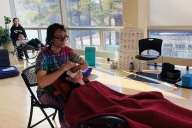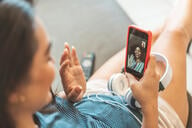You have /5 articles left.
Sign up for a free account or log in.

iStock.com/csheezio
When the dominoes fell in March, it was swift. The University of Washington was the first to switch to remote learning, followed by other Seattle colleges, the West Coast and eventually the country.
For months, observers have been on the lookout for fall’s first domino, the one that will take them all down. Worthy contenders -- Johns Hopkins University, Princeton University, the University of Massachusetts at Amherst -- have all come and gone.
Some thought the University of North Carolina at Chapel Hill could be that domino. Chapel Hill is a major research university, a Football Bowl Subdivision player and -- like many other universities planning to bring back students -- a public university in a largely Republican-controlled state.
After 135 coronavirus cases, a media frenzy and a foulmouthed editorial in the student newspaper, Chapel Hill decided to send students home Monday after nine days of class, a potential warning to any college leader hoping to resume in-person classes.
Chapel Hill was followed within 24 hours by other significant and serious announcements. Michigan State University will be starting its semester online, and the University of Notre Dame will hold classes online, close public spaces and close residence halls to nonresidents for two weeks in a last-ditch effort to keep campus open. The Indiana university has 147 total cases.
But the thing about the fall is that the dominoes are not lined up neatly in a row, as they were last spring. Recent announcements have the makings of a wave, but the response by colleges is in nearly every way more diffuse than it was in March. While some have thrown in the towel, others will not let one or two bad examples be their cue to give up.
Within the UNC system itself, chancellors at other colleges are so far holding their ground, despite having a few clusters of their own.
“I’ve said it before and I’ll say it again: we achieve our mission -- student and regional success -- at much higher levels when we can operate in-person,” said Ron Mitchelson, interim chancellor of East Carolina University, in a news release. The university has had at least 108 positive tests among its students and employees.
At Appalachian State University, the Faculty Senate voted in favor of a resolution to hold the UNC system Board of Governors and Appalachian State chancellor Sheri Everts responsible for any illness or death that occurs as a result of reopening. But the administration presses on.
“We are in constant communications with UNC System officials, as well as our local public health experts, to monitor conditions on our campus, and there are no immediate plans to change our course delivery methods at App State,” wrote Everts in a campus letter.
App State has had 162 cumulative cases (99 of them among students) and recently placed a fraternity on suspension pending an investigation for failure to follow safety standards around in-person gatherings.
“I expect the circumstances are sufficiently different in different institutions and in different localities, that the impact of an individual institution's experience, good or bad, will be less important than some might imagine,” John V. Lombardi, former leader of three public institutions, said via email. “More importantly for the institution is the extent to which the plans they have developed for monitoring and testing and dealing with infections appear to be working as well as they hoped.”
Though the UNC debacle may have forced college leaders to watch in real time the news frenzy they could be in for if things go south, Lombardi said that how administrations respond to bad publicity is a subject for their boards.
“The sensitivity of any university to press commotion is often a function of the strength of the board of trustees,” he said via email. “If the trustees are weak, divided or overly political, then the press noise can have a significant impact since the university's authority to do what it needs to do is, in the end, dependent on the strength of the trustees.”
Chuck Staben, former president and current professor of biology at the University of Idaho, said many college presidents are likely not dissuaded by media fallout, as the financial pressure to run classes in person is so great.
“I don’t think any president or chancellor wants to have bad press, but I think they’re also powerfully motivated to have in-person, on-campus classes,” he said. “In most of their minds, the possibility that they can hold on-campus classes outweighs the potential for negative publicity.”
The real decisions for college leaders likely begin, Staben said, when cases increase and questions arise about whether to send students home or try more stringent measures.
“I have very little confidence that we can have a normal semester or anything close to a normal semester on our campuses,” he said.
Large public universities outside North Carolina have responded to the news, in their communications, at least, with resolve. They have emphasized their flexibility.
Texas A&M University, for example, is still set to begin in-person classes today. Over 75 percent of students will have at least one in-person course.
"We will not go all-or-nothing this semester. The first classes we would move to remote-only are the very large classes. Then, if the infection continues, we’ll make classes smaller and smaller," said Provost Carol Fierke via email. "Because we’re doing every class face-to-face and remote already, we can easily switch to remote -- and back again -- if things look better later in the semester."
Fierke said A&M is looking at about 20 metrics to make decisions about teaching modalities, including ability to quarantine and available childcare.
Pennsylvania State University will be starting classes Monday.
“Penn State is prepared to be nimble and responsive based on the latest information, monitoring and evolving virus infection rates. All classes that are planned to have in-person meetings will have contingency plans for reverting to remote instruction modalities if health circumstances require ending in-person learning earlier than Nov. 20,” said a spokesperson for the university via email. Changes in the caseload or public health capacity, among other factors, he said, could result in a changed modality.
Before the plug was finally pulled on Chapel Hill, the university showed itself to be insensitive to a number of other pressuring factors. Faculty explicitly told students to stay home, while local public health officials urged the university to restrict student housing and consider online learning for at least the beginning of the semester.
Similar pressures are mounting at other colleges. A Boston City Councilor has urged local universities to switch to online, for one example. (Note: A previous version of this article said Boston's mayor had urged Boston University and Northeastern University to hold online only classes. This is incorrect.)
Cases at Notre Dame and Chapel Hill have been traced to off-campus parties, which several other universities, including the University of Alabama, the University of North Georgia and Oklahoma State University, also seem to be struggling with.
In some parts of the country, universities have said they will be holding in-person classes while peers in their immediate geographic area have gone online. Cornell University (which is holding classes for some students) and Ithaca College (which as of Tuesday shifted to fully online) are one such example, in a situation that would have been quite unlikely in March.
“All the external pressure favored reopening,” said Terry Hartle, senior vice president of government and public affairs at the American Council on Education. “Leaders at institutions that did decide to reopen were acutely aware that it wouldn’t be easy and might not be possible.”
“I would predict some schools will reopen and remain open for the fall. I would predict other schools will reopen and be forced to close,” he added. “Despite all the planning and resources invested, they couldn’t make it work in Chapel Hill.”




